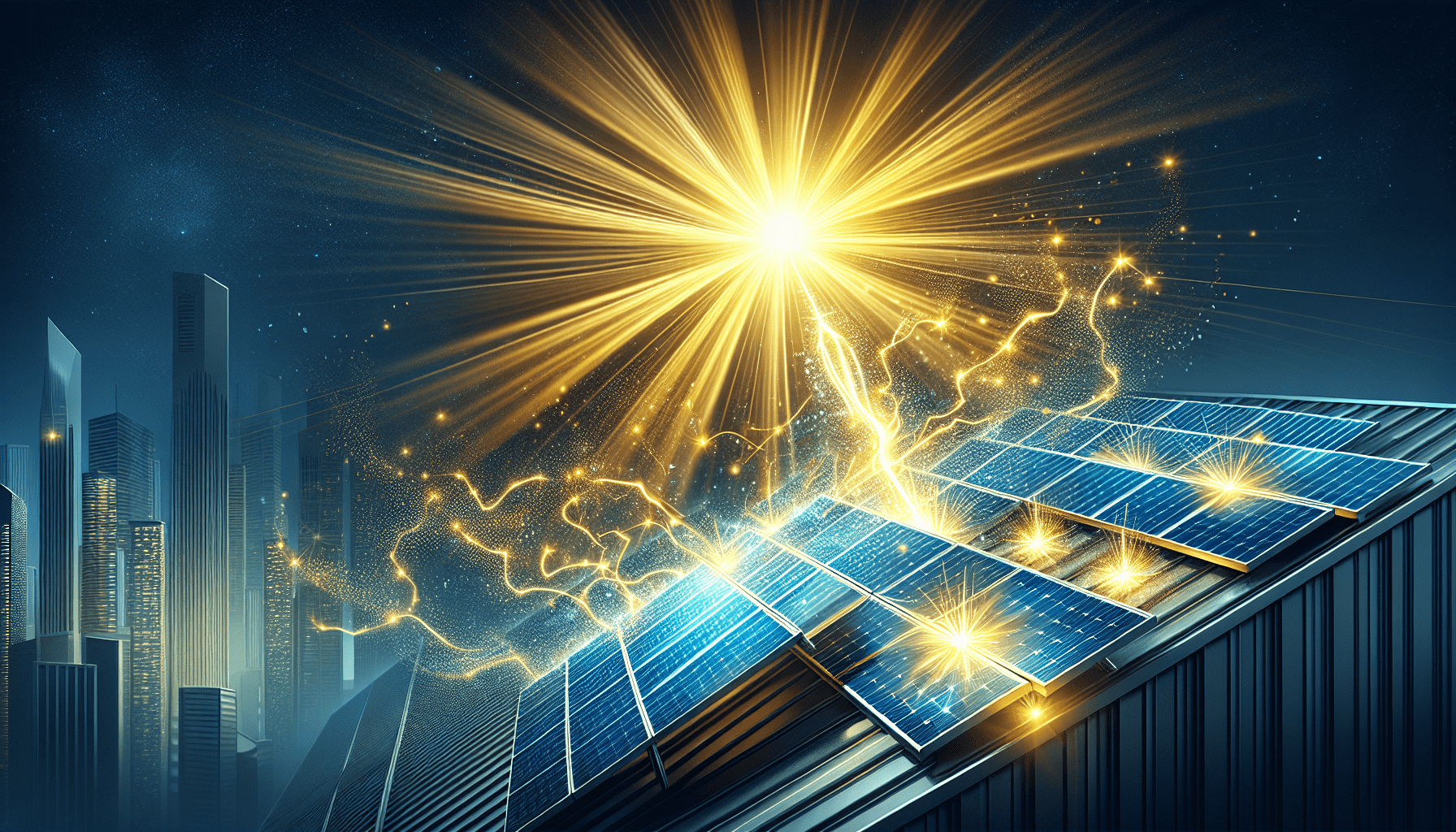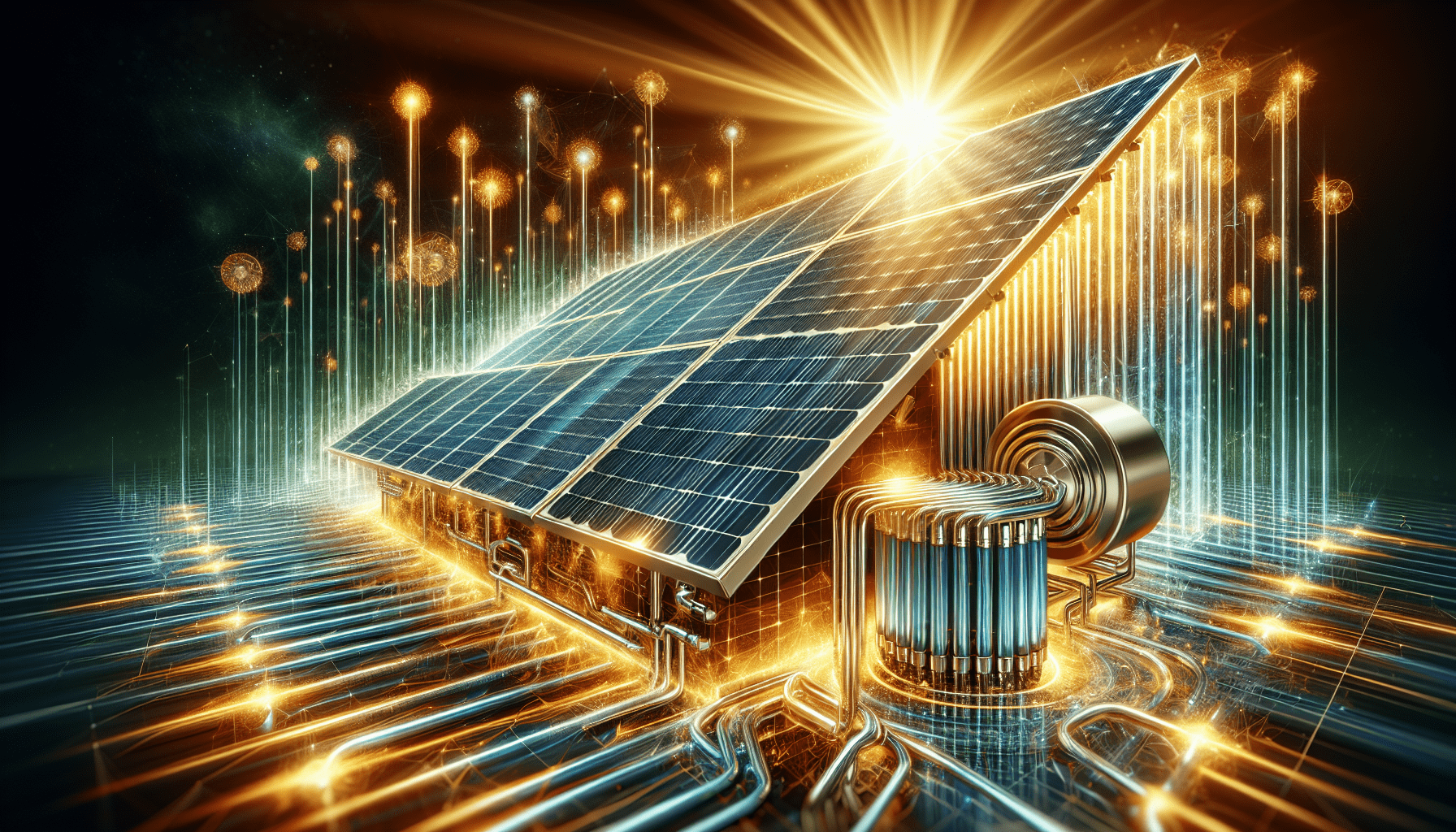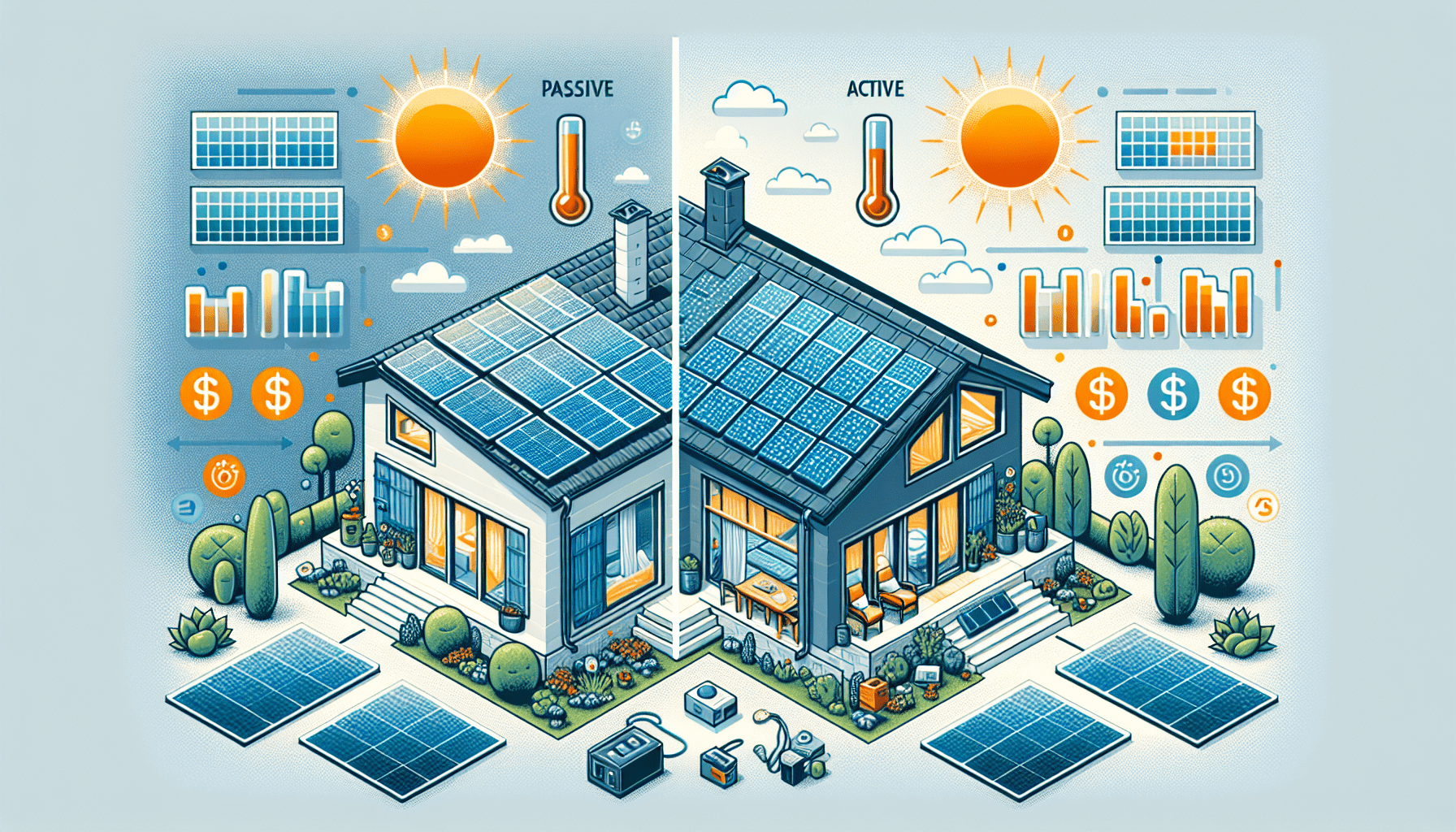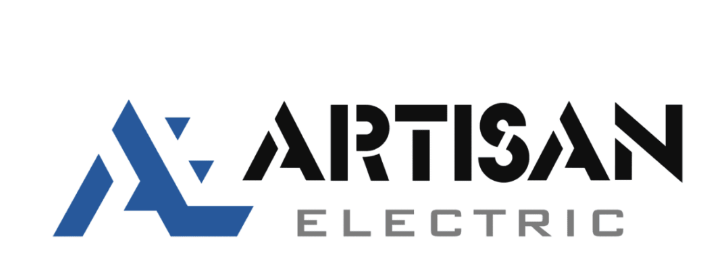When it comes to harnessing solar energy, there are two main approaches: passive and active solar energy. Passive solar energy uses smart design elements to collect and distribute heat naturally, while active solar energy relies on mechanical and electrical devices to capture and store solar power. In this article, we’ll break down the key differences between passive and active solar energy, helping you figure out which system might be the best fit for your needs.
Key Takeaways
- Passive solar energy uses building design elements to harness the sun’s heat, while active solar energy relies on mechanical and electrical devices for capturing and using solar power.
- Passive systems are cost-effective, low-maintenance, and great for the environment, but they work best in sunny climates and can be a bit tricky to design.
- Active systems are more efficient and versatile, able to provide consistent heating and electricity even in less sunny climates, though they come with higher installation costs.
Understanding Solar Energy

Solar energy is a clean, renewable source of power that captures the sun’s energy through its rays to generate electricity. The magic happens with photovoltaic (PV) cells, which convert sunlight directly into electricity using semiconductor materials. When sunlight hits a PV cell, it creates an imbalance of electrical charge between the cell’s surfaces, generating electricity. This technology is a game-changer in our move towards sustainable energy sources.
Right now, solar energy makes up around 1.3% of the total energy used worldwide. But hold on, it’s set to explode in popularity! By 2050, solar power is expected to be one of the top energy sources, thanks to continuous tech advancements and more people jumping on the solar bandwagon. The efficiency of PV panels has come a long way, from less than 10% in the mid-1980s to nearly 25% for the latest models today. These improvements make solar energy more accessible and practical for both homes and businesses.
The environmental perks of solar energy are a big deal too. Here are some of the top benefits:
- Solar energy is clean and doesn’t produce harmful emissions, which helps reduce our carbon footprint and fight climate change.
- It’s abundant and easy to access, making it a sustainable power source.
- Investing in solar panels and other solar tech can cut down our reliance on fossil fuels and promote a greener planet.
- Solar energy can help lower energy bills, offering economic benefits to both individuals and businesses.
By tapping into solar energy, we can pave the way for a more sustainable and eco-friendly future.
Now that we’ve got a solid grasp on solar energy, let’s dive into the nitty-gritty of passive and active solar systems.
What Is Passive Solar Energy?

Passive solar energy harnesses the sun’s heat without relying on mechanical systems. Instead, it uses building design elements like windows, walls, and floors to collect, store, and distribute solar heat. The concept is simple yet effective: by strategically placing windows and using materials like brick, stone, and water, passive solar systems can naturally regulate indoor temperatures.
Some cool features of passive solar systems include:
- Thermal mass materials that soak up heat during the day and release it at night, keeping the temperature comfy inside
- South-facing windows that let in the maximum amount of sunlight
- Overhangs or shading devices that stop your place from getting too hot in the summer
- Insulation to keep the heat in during the winter
By incorporating these design elements, passive solar systems can cut down the need for artificial heating and cooling, saving energy and making your living space more eco-friendly.
One popular method is the direct gain approach, where sunlight comes in through south-facing windows and hits masonry floors and walls that absorb the heat. Another method is the Trombe wall, an indirect-gain system where a thick masonry wall soaks up and stores solar heat, releasing it into the living space later. With the right design and materials, a passive solar system can significantly reduce heating and cooling needs, making it a green and cost-effective solution.
Advantages of Passive Solar Systems
The cost-effectiveness of passive solar heating systems comes down to their low maintenance needs and the fact that they don’t rely on mechanical or electrical devices. This simplicity means lower long-term costs and fewer things that can break. Plus, passive solar systems are super eco-friendly sincethey cut out the need for conventional energy sources like electricity or natural gas. By using less fossil fuel, they help reduce greenhouse gas emissions and promote sustainability.
On top of the financial and environmental perks, passive solar systems also bring some cool design benefits. They can provide natural daylight all year round, making your indoor space brighter and cutting down on the need for artificial lighting. Features like sunspaces or solariums not only add extra heat but also create sunny spots that can boost your mood and quality of life.
In short, passive solar systems mix practicality with aesthetic appeal, making them a great choice for eco-conscious homeowners.
Disadvantages of Passive Solar Systems
Despite all the good stuff, passive solar systems do have some downsides. One big issue is their efficiency in less sunny climates. For example, in places with lots of rain or cloudy weather, like Washington State, passive solar systems might not work as well. Since they rely on sunlight, these systems can be a bit inconsistent, giving you less heat when there’s not much sun.
Another drawback is the complexity of designing an effective passive solar system. The ideal ratio of thermal mass to glazing varies by climate, making the design process tricky and often requiring computer models to test different setups. This complexity can be a hurdle for those looking to set up a passive solar system without professional help.
Even with these challenges, passive solar systems remain a viable and attractive option for many homeowners.
What Is Active Solar Energy?

Active solar energy systems take a more high-tech approach to capturing the sun’s energy. These setups use solar panels, solar water heaters, and other cool gadgets to grab, store, and circulate solar heat. Unlike passive systems, active solar energy relies on mechanical and electrical devices to boost efficiency and give you more control. For instance, solar collectors turn sunlight into heat, which is then stored for later use.
Active solar energy systems are super versatile and can be used for all sorts of things, like heating your water, keeping your house warm, and even generating electricity. They often include parts like heat exchangers, small fans, and blowers to move the collected heat around your place. This flexibility makes active solar energy systems great for different climates and building types, offering consistent and reliable performance.
Types of Active Solar Systems
Active solar heating systems come in a few different flavors, each with its own perks. Some popular types include:
- Liquid-based systems: These use a liquid to transfer heat, which can be used for heating water or air.
- Air-based systems: These use air to transfer heat through solar collectors.
- Hydronic collectors: These use water or antifreeze solutions to soak up and transfer solar heat.
- Integrated systems: These can be hooked up to your existing HVAC systems, making them even more efficient and flexible.
Solar thermal systems use solar collectors to grab heat, which is then used to warm water or air. This heat can be stored in tanks or radiant slab systems for later use. The ability to adapt to different climates and work with existing heating systems makes active solar systems a practical choice for many homeowners and businesses.
Benefits of Active Solar Heating Systems
Active solar heating systems offer a bunch of benefits, making them a solid option for those looking to cut down on traditional energy sources. An active solar heating system can cover 40-80% of a home’s heating needs, slashing energy bills and reducing your environmental footprint. The ability to store and release heat on demand ensures consistent performance, even when the sun isn’t shining.
Another big plus is their adaptability to different climates and the ability to work with existing heating systems. Whether you’re in a sunny or not-so-sunny area, active solar systems can be tailored to fit your needs. This versatility, combined with the potential for big energy savings, makes active solar heating systems a compelling choice for many homeowners.
Comparing Passive and Active Solar Energy

If you’re making a decision between passive and active solar energy, you need to consider various factors like installation costs, efficiency, and local climate conditions. Active solar systems are more efficient and can store energy for later use because they use photovoltaic panels. On the other hand, passive solar systems depend a lot on building design and location, which can limit their efficiency in less sunny spots.
Active solar systems generally perform better, especially in areas with inconsistent sunlight, like Washington. But passive solar systems can be more cost-effective and eco-friendly since they use the natural flow of heat through building materials. Understanding these differences is crucial to making the right choice for your needs.
Cost Comparison
When it comes to costs, passive and active solar energy systems have their own pros and cons. Passive solar systems usually have lower installation costs because they rely on building materials and design instead of mechanical devices. For instance, Trombe walls and big south-facing windows can be added cost-effectively to harness the sun’s heat. This makes passive solar heating systems a great option if you’re looking to keep upfront costs low.
Alternatively, active solar systems typically have higher initial costs due to for solar panels, inverters, and other mechanical parts. However, the long-term savings on energy bills and the ability to provide consistent heating even in less sunny climates can make up for these initial expenses. Ultimately, the choice between passive and active solar systems will depend on your budget and specific energy needs.
Efficiency and Performance
The higher efficiency and capacity of active solar systems are well-known. They can cut down energy use by 22% and slash electricity costs by 32% compared to passive systems with the same energy storage capacity. Thanks to photovoltaic panels and the ability to store energy for later, active solar systems are a dependable choice for steady heating and electricity.
Conversely, passive solar systems rely a lot on the building’s design and where it’s located, making them less effective in places with less sunshine. For example, passive solar heating shines in areas with plenty of year-round sun, while active systems can still perform well in places with less consistent sunlight, like western Washington and the Puget Sound area. Knowing these efficiency and performance differences is crucial to picking the right solar system for your needs.
Choosing the Right Solar System for Your Needs
Choosing the right solar system for your needs means thinking about factors like cost, location, and personal preferences. If you’re in a sunny area and want a cost-effective, low-maintenance solution, a passive solar energy system might be your best bet. These systems are perfect for those looking to use building design to capture solar heat without needing mechanical devices.
For those in areas with less consistent sunlight, like western Washington and the Puget Sound area, active solar energy systems offer more reliable performance. These systems can provide steady heating and electricity, even when the sun isn’t shining much. Plus, the ability to hook up with existing heating systems makes active solar energy a flexible and adaptable choice.
By carefully considering these factors, you can make an informed decision that fits your energy needs and environmental goals.
Summary
In a nutshell, both passive and active solar energy systems have their own set of perks and challenges. Passive solar systems are cost-effective, eco-friendly, and low-maintenance, making them great for sunny regions. However, their efficiency heavily depends on building design and location, which can be a downside in less sunny areas.
Active solar systems, on the other hand, offer higher efficiency and capacity, making them suitable for various climates and uses. While they come with higher upfront costs, the long-term savings and steady performance can make them a smart investment. Ultimately, the choice between passive and active solar energy systems depends on your specific needs, budget, and location. By understanding these differences, you can make a decision that supports your energy goals and helps create a more sustainable future.
Frequently Asked Questions
What is the main difference between passive and active solar energy systems?
Passive solar energy systems use clever building designs and materials to grab and store heat from the sun. On the other hand, active solar energy systems use tech like solar panels and gadgets to capture, store, and spread that heat around. Basically, passive systems keep it natural, while active systems go high-tech.
Are passive solar energy systems more cost-effective than active systems?
Yes, passive solar energy systems are easier on the wallet compared to active systems. They come with lower installation costs since they rely on smart building designs and materials
Can active solar energy systems work in regions with less consistent sunlight?
Yep, active solar energy systems can totally work in places with less consistent sunlight, like Seattle. They can still provide steady heating and electricity, even when the sun’s playing hide and seek.
What are some common types of active solar heating systems?
Some popular types of active solar heating systems include liquid-based systems, air collectors, and hydronic collectors. These can all be hooked up to your existing HVAC setup to make the most out of solar energy for heating.
What are the environmental benefits of using passive solar energy systems?
Using passive solar energy systems means you don’t have to rely as much on traditional energy sources like electricity and natural gas. This cuts down on greenhouse gas emissions and is a win for the environment.

